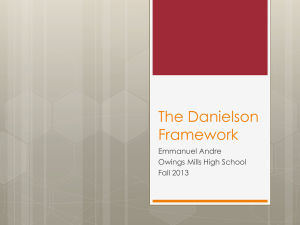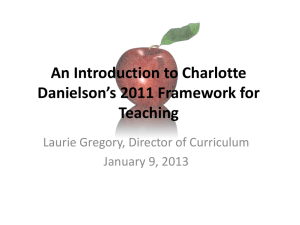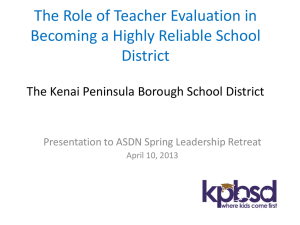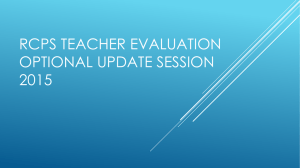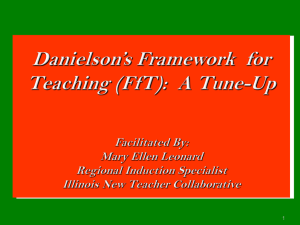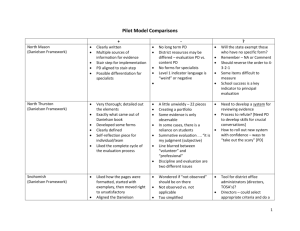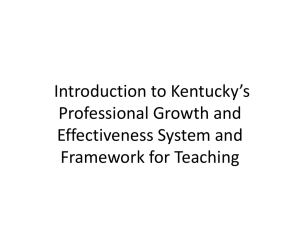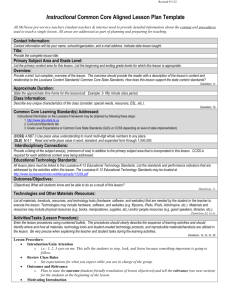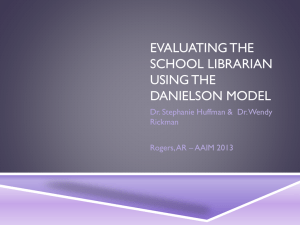Danielson Framework Review & Card Sort Activity
advertisement
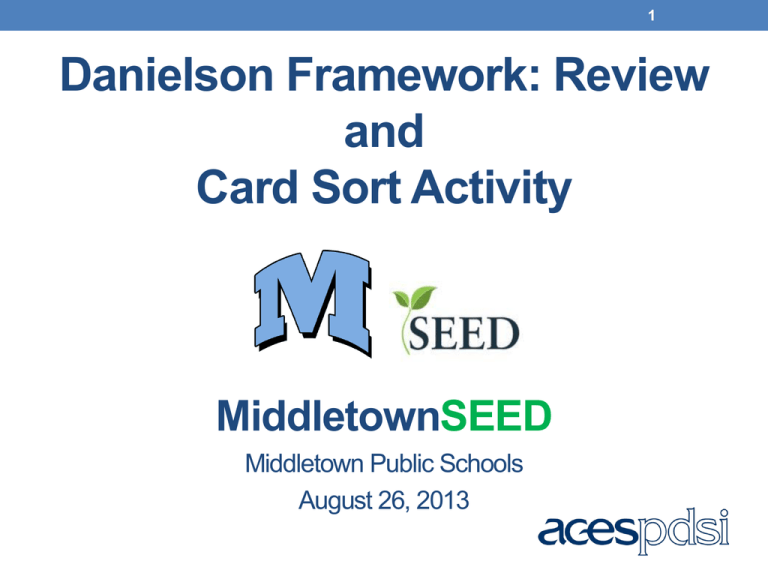
1 Danielson Framework: Review and Card Sort Activity MiddletownSEED Middletown Public Schools August 26, 2013 2 Lee Shulman, Educational Psychologist “Teaching is perhaps the most complex, most challenging, and most demanding, subtle, nuanced, and frightening activity that our species has ever invented… The only time a physician could possibly encounter a situation of comparable complexity would be in the emergency room of a hospital during a natural disaster.” 3 Domain 1 Planning and for Active Preparation Learning Domain 2 Classroom Environment Components: 2a Creating an Environment of Respect & Components: Rapport 2a. Creating an Environment of Respect & Rapport 2b CultureofofLearning Learning 2b. Creating Creating aaCulture 2c ClassroomProcedures Procedures 2c. Managing Managing Classroom 2d StudentBehavior Behavior 2d. Managing Managing Student 2e Managing ManagingPhysical PhysicalSpace Space 2e. 1a. Demonstrating Knowledge of Content & Pedagogy 1b. Demonstrating Knowledge of Students 1c. Setting Instructional Outcomes 1d: Demonstrating Knowledge of Resources 1e. Designing Coherent Instruction 1f. Designing Student Assessments The Danielson Framework: Teaching Evaluation Instrument Domain 4 Professional Responsibilities Domain 3 Instruction Components 3a Communicating with Students Components: 3b Questioning Discussion Techniques 3a. Using Communicating with and Students 3c Students in Discussion Learning Techniques 3b. Engaging Using Questioning and 3d Assessment Instruction 3c. Using Engaging Students ininLearning 3e Flexibility & Responsiveness 3d. Demonstrating Using Assessment in Instruction 4a. Reflecting on Teaching 4b. Maintaining Accurate Records 4c. Communicating with Families 4d. Participating in a Professional Community 4e. Growing and Developing Professionally 4f. Showing Professionalism 3e. Demonstrating Flexibility & Responsiveness 4 Review of Danielson Framework • Read the Danielson Framework documents which can be found in folders. • Conduct a small group (no more than 4 people per group) table discussion about the Domains, Components, and Elements of the Framework. How are the Domains similar and/or different? Mention common themes. How does the Framework support each teacher with refining his/her practice? • Educators will share out findings, and facilitator will list on chart paper. 5 Card Sort Activity Domain, Component, and Element 6 Card Sort Activity Directions • Take out the different color scenario cards from your folders. One scenario card set must become the TABLE SET! • Determine what the different colors of the cards signify (4 Colors = 4 Domains). • At your table group: One person reads the scenario; together determine which Domain, Component, and Element is represented; indicate that on a post-it note, and place it on the TABLE SET scenario card. MAKE ONE PILE of the TABLE SET SCENERIO CARDS at each table. • Once your group has completed all the cards; count off by 4s. 7 Card Sort Activity Directions • Split up into 4 “expert groups” according to Domains/Colors. (Domain 1: Group 1; Domain 2, Group 2, etc.) Move to your “expert group” with the TABLE SET cards that represent your Domain (if you are a # 1 then take Domain 1 cards with you to your new group, etc.). • Facilitator will provide each expert group with an answer key to their specific cards. Check your answers with the answer key and discuss your responses. • Return to your original table group and review any responses that your original group missed.
